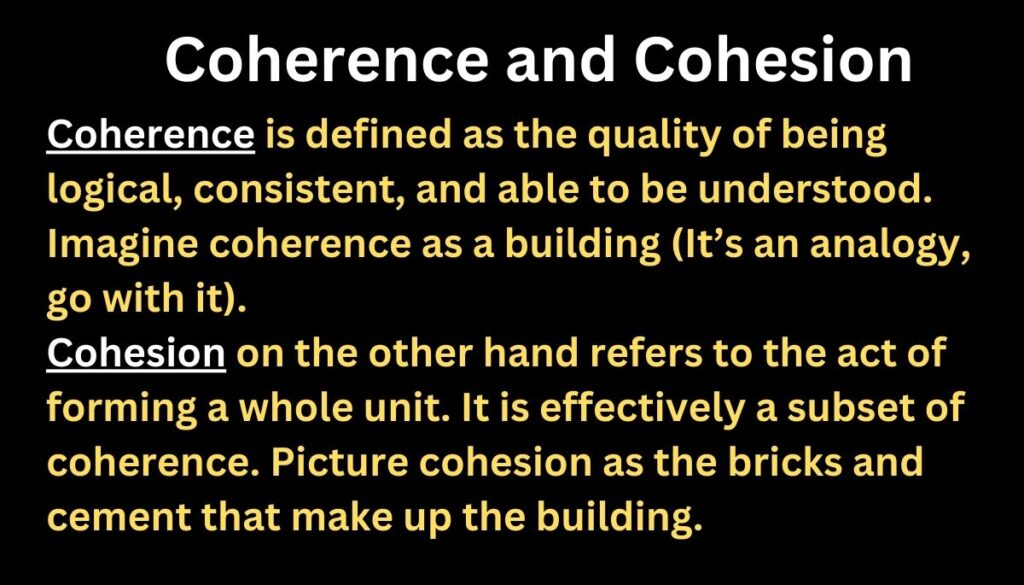This post includes a detailed description of cohesive devices along with the components of lexical cohesion in coherence and cohesion.
Lexical cohesion involves the choice of vocabulary. It is concerned with the relationship that exists between lexical items in a text such as words and phrases, in particular, content words, and the relationship between them.
The main kinds of lexical cohesion are repetition, synonymy, antonymy, hyponymy, meronomy, and collocation.
Let’s have a look at the lexical Cohesive Devices:
Repetition
This lexical item refers to words that are repeated in a text. Repetition is the restatement of the same lexical item. This helps to focus your ideas and to keep your reader on track.
This is illustrated by the following:
“Anna ate the apple. The apple was fresh”
(“The apple” is an example of repetition)
“The problem with contemporary art is that it is not easily understood by most people. Contemporary art is deliberately abstract, and that means it leaves the viewer wondering what she is looking at.”
(Contemporary art is an example of repetition)
Synonymy
Synonyms refer to words that are similar in meaning. Synonymy is used to refer to items of similar meaning just as
Examples:
attractive = beautiful, broad=wide, hide=conceal, almost=nearly, cab=taxi, liberty=freedom, answer=reply.
Myths narrate sacred histories and explain sacred origins. These traditional narratives are, in short, a set of beliefs that are a very real force in the lives of the people who tell them.
(Myths and Traditional Narratives are synonyms for each other)
Antonymy
Antonyms describe opposite or contrastive meanings. It is the relation between items of opposite meanings.
Examples
hot and cold, quick=slow, big=small, long=short, rich=poor, happy=sad, hot=cold, old=young, male=female, true=false, alive=dead.
Hyponymy
Hyponymy, then, refers to classes of lexical items where the relationship between them is one of ‘general-specific’, ‘an example of’, or in a ‘class to member’ type relationship. In the example below, Animals is a superordinate term while cat and dog are its hyponyms.
Both Cat and Dog are co-hyponyms for each other.

When the meaning of one form is included in the meaning of another, the relationship is described as a hyponym. For example
Daffodil= Flower, dog= animal, poodle= dog, carrot= vegetable, banyan= tree.
The concept of “inclusion’ is involved here.
For example:
If any object is a daffodil, then it is necessarily a flower, so the meaning of the flower is included in the meaning of the daffodil. Daffodil is a hyponym of a flower.
We look at the meaning of words in some type of hierarchical relationship. (Tree-Diagram).
Meronymy
Meronymy is where lexical items are in a ‘whole to part’ relationship with each other, such as the relationship between ‘Alia’ and ‘Saad’ in relation to the item ‘couple’.
‘Alia’ and ‘Saad’ are co-meronyms of the superordinate item ‘couple’. The couple is whole while Alia and Saad are its parts. Alia and Saad are co-meronyms to each other.

More examples are:
Car (Whole) Wheels (Part) Doors (Part) Mirror (Part)
House (Whole) Room (Part) Gate (Part) Roof (Part)
Collocation
Collocation describes associations between vocabulary items that have a tendency to co-occur such as combinations of adjectives and nouns, as in ‘real-estate agent’ and the ‘right direction’.
For example:
If you ask a thousand people what they think when you say ‘hammer’, more than half will say ‘nail’, if you say ‘table’ they will mostly say ‘chair’, and for ‘butter- bread, for needle- thread, for salt- pepper.
Some collocations are joined pairs of words such as salt and pepper or husband and wife.
It includes combinations of adjectives and nouns such as, ‘fast food’, verbs and nouns such as, ‘run out of money’, and other items such as, ‘men’ and ‘women’ (Platridge, 2012).
A writer and speaker of a language draw on this knowledge of collocations as he/she writes and speaks. Expert writers (and readers) know that only certain items collocate with each other. That is, we know we can say ‘real-estate agent’ but not ‘real-estate fruit and vegetables’.
Or that we can say ‘fresh fruit and vegetables’ but not (with the same meaning) ‘fresh real-estate agents’. This knowledge of collocation is another way in which a text has the property of texture.

